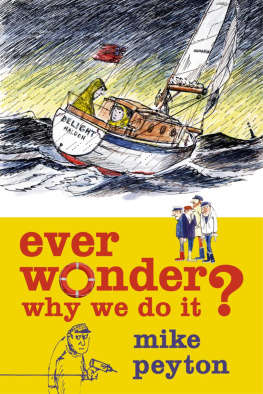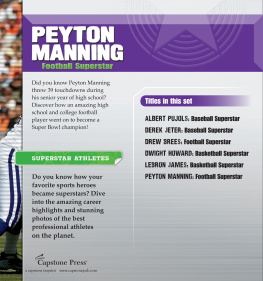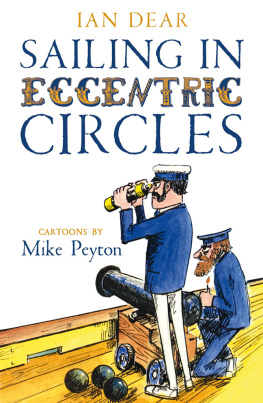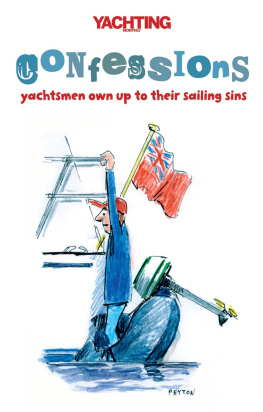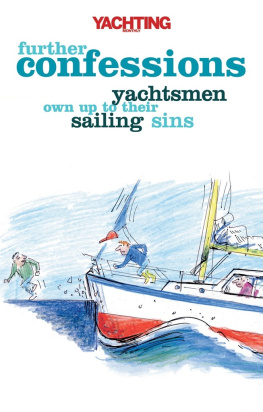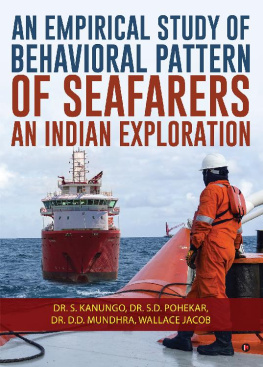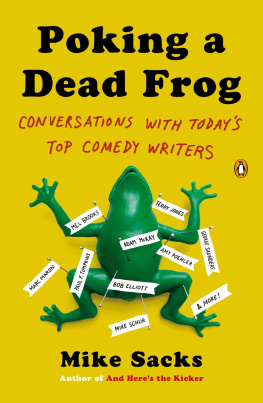To all the friends I have
sailed with, with fond
memories.
Drawing on experience
One of the delights of working at Yachting Monthly magazine is opening an envelope each month from which spill Mike Peytons colourful cartoons. He is best known for his illustrations for The Confessional, where readers own up in print to their most embarrassing sailing moments.
It would probably make Mike shudder to be called an institution in yachting, but thats what he is and a much loved one, too. His cartoons and occasional articles have graced the pages of our magazine, and others, for more than 35 years, causing ripples of laughter from the Thames Estuary to Tahiti. Mike has seen off more editors than any other contributor in our 101-year history. Yet he remains a modest, almost shy man, unaware of the esteem in which he is held.
Here is a man who can literally draw on his experiences. Mikes mischievous sense of satire is informed by his own inimitable exploits on the water in a succession of odd craft. After studying at Manchester Art School, he bought a 12ft canvas sailing canoe from a man in a Richmond pub. He worked his way down the River Thames sleeping on moored barges and remembers frying breakfast on a primus stove under the shadow of Big Ben. Eventually, he reached salt water and learned to cope with tides and how to reef sails the hard way. His own first proper boat was 24ft Vagrant, so-called because she had no visible means of support.
In the primeval East Coast mud, Mike discovered a whole emerging sub-species of the yachting world. Perhaps because yachting in those days was a serious business sailors wore peaked caps and ensigns were lowered at sunset Mike felt impelled to stick a pin in the balloon of sailing snobbery and pomposity.
With a few strokes of his pen and a few squiggly lines though, of course, theres far more to it than that! Mikes down-to-earth sense of humour transports you to the heart and soul of sailing dilemmas. For me, theres no other sailing cartoonist in the world who can match his elegant, economical wit and wisdom. Mikes humour may be merciless, but its also gentle rather than vulgar, brash or cruel. To an editor Mike Peyton is a gift and a joy.
He is not only a superb draughtsman, but he also has a winning way with words, whether its a double-entendre, a clever punch line, headline or caption. He is also an exceptional raconteur, as anyone who has sat below in the cosy saloon of Touchstone, his current boat, with the coal stove glowing, can testify after listening to his yarns.
Mike has been a unique commentator on the sailing scene for more than 50 years. He tells me he gets his best cartoon ideas sitting in the bath. Perhaps its the catalyst of being surrounded by water instead of East Coast mud!
Meanwhile, at the tender age of 86, he goes sailing in his favourite Essex creeks and swatchways whenever wind and weather permit he still goes skiing, too! But these days he tries to avoid cartoon situations... mostly with success!
Paul Gelder
Editor of Yachting Monthly magazine
My sailing experience had been pretty near minimal when I bought my first cruising boat, on an impulse. I had the loan of a heavy, eight foot, flat-bottomed, gunter rigged dinghy for about a month and in her I discovered the joys of running before the wind, tempered only by the knowledge that the further I ran the further I would have to row back. On the basis of these experiences having, in a manner of speaking, discovered the beginning of the trail to the Holy Grail, I set off to hire a cruising boat for a weeks holiday and fell by the wayside. As Ive said, it was an impulse buy, and there I was, an instant yachtsman. And, since it took almost all of our savings, almost an instant bachelor.
However, as we had signed up for better or for worse we survived, me getting the better in this case.
The boat I now owned had, in a sense, been bought out of `trade. She had been what was known as a penny sick, taking holidaymakers from Southend beach to the end of the pier and back. She was a 7.3m x 2.5m x 0.5m (24ft x 8ft 6ins x 1ft 6ins) gaff sloop rigged centre-boarder. Originally an open boat, her topsides had been built up by her previous owner to give sitting headroom and her decks were covered with thick red lino. She had a large cockpit, had been used as a floating caravan, and had never sailed beyond Burnham. Now, with all honesty, I can describe her as a box with a pointed end, but then no feeble words of mine would have been adequate enough to describe what I thought of her. I used to sit on the seawall just looking at her.
On our first sail I doubt if any boat ever went to sea with such a crew of amateurs on board. In the first place we had no intention of going to sea when we set off, as the sum total of our combined experience was me being on the delivery trip, all of three miles down the river with the previous owner on board, and my running-cum-rowing outings. The rest of the crew were Tommy, a neighbour and ex-army friend, who had seen the sea before and Gabor, a Hungarian refugee, who hadnt.
We also had on board, by proxy in a manner of speaking, one Peter Heaton, in my eyes one of the finest and most underestimated authors these Islands have produced. He was the author of an invaluable Penguin paperback called Sailing, and no tablets of stone were ever studied with such reverence and dedication as was that book. Gabor had his new English Hungarian Dictionary we flipped through them in unison, both at about the same level of competence. The plan was simply to sail down the River Crouch and sail back. But sailing being what it is, it didnt work out like that.
On that distant halcyon day when we set sail from the upper reaches of the Crouch, Gabor had sole charge of the boathook with a roving commission. Tommy and I had the rest of the boat and Peter Heaton had pride of place on the engine box; on call as one might say. The boat actually had an engine, an 8hp Brooke Marine, but it wasnt working. However this worried me not, as the accepted advice of the time was that one should eschew engines until one was competent enough to handle ones boat under sail. Im very good at eschewing. Its so simple. So I eschewed. I was to regret it later.
We ran down the Crouch with a fresh south-westerly behind us and the tide under us in a state of bliss. With hindsight I realise the novelty of it all for Gabor must have been out of this world. But when at Shore Ends, with open sea before us, I tried to return and found I couldnt. The wind that had wafted us down, now that we were trying to go against it, went up considerably in strength and I literally couldnt control the boat. I found out later she had once been cutter rigged with a bowsprit and now without the bowsprit and the jib she was completely unbalanced. I didnt know enough to reef the main to redress this, or have enough sense to anchor and wait for the tide to turn. The engine I had eschewed and my normal answer to this problem, rowing, were both out of the question. And in our hour of need Mr Heaton deserted us, slipping from his place of honour on the engine box into the bilges and was pulp before we could spare the time to rescue him. We did the only thing we knew how to: we ran before it.

